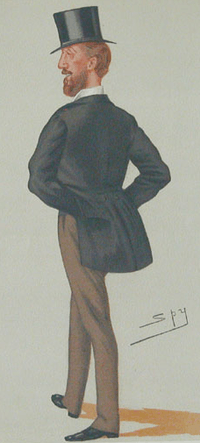Lord Henry Thynne
Lord Henry Frederick Thynne PC, DL (2 August 1832 – 28 January 1904) was a British Conservative politician. He served under Benjamin Disraeli as Treasurer of the Household between 1875 and 1880.
Lord Henry Thynne DL | |
|---|---|
 Lord Henry Thynne by Leslie Ward, 1877. | |
| Treasurer of the Household | |
| In office 14 December 1875 – 21 April 1880 | |
| Monarch | Victoria |
| Prime Minister | Benjamin Disraeli |
| Preceded by | Earl Percy |
| Succeeded by | The Earl of Breadalbane |
| Personal details | |
| Born | 2 August 1832 |
| Died | 28 January 1904 (aged 71) |
| Nationality | British |
| Political party | Conservative |
| Spouse(s) | Lady Ulrica Seymour (d. 1916) |
| Children | Ulric Oliver Thynne & Rachel Thynne |
Background
Thynne was the second son of Henry Thynne, 3rd Marquess of Bath, and his wife the Honourable Harriet Baring, daughter of Alexander Baring, 1st Baron Ashburton. John Thynne, 4th Marquess of Bath, was his elder brother.[1]
Political career
Thynne entered the House of Commons in 1859 as Member of Parliament for South Wiltshire, a seat he held until 1885,[1][2] and served under Benjamin Disraeli as Treasurer of the Household from 1875 to 1880.[1] In 1876 he was admitted to the Privy Council.[3] Apart from his political career he was also a Major in the Wiltshire Yeomanry Cavalry and a Deputy Lieutenant for Wiltshire.[1]
Family
Thynne married on 1 June 1858 Lady Ulrica Frederica Jane Seymour, daughter of Edward Seymour, 12th Duke of Somerset. They had four sons and two daughters:[4]
- Thomas Ulric Thynne (b.1861), Royal Navy officer; m. 1898 Dorothy Mary Warner, daughter of Charles William Warner, CB
- John Alexander Roger Thynne (b.1864)
- Colonel Ulric Oliver Thynne, DSO (1871–1957), British Army officer; m. 1899 Marjory Wormald, daughter of Edward Wormald, and had issue
- Oliver St Maur Thynne (b.1901)
- Alice Rachel Thynne
- Alice Ruth Hermione Thynne; m. 1889 Alexander Edward Lane Fox-Pitt Rivers
Lord Henry died in January 1904, aged 71. Lady Ulrica survived him by twelve years and died in January 1916.[1]
References
- thepeerage.com Rt. Hon. Lord Henry Frederick Thynne
- Leigh Rayment's Historical List of MPs – Constituencies beginning with "W" (part 4)
- leighrayment.com Privy Counsellors 1836–1914
- Debrett′s peerage, 1903
- Burke, Sir Bernard, (1938 ed) Burke's Peerage, Baronetage and Knightage. Shaw, London. p. 243
- Woodfall, H. (1768). The Peerage of England; Containing a Genealogical and Historical Account of All the Peers of that Kingdom Etc. Fourth Edition, Carefully Corrected, and Continued to the Present Time, Volume 6. p. 258.
- Lee, Sidney; Edwards, A. S. G. (revised) (2004). "Thynne, William (d. 1546)". Oxford Dictionary of National Biography (online ed.). Oxford University Press. doi:10.1093/ref:odnb/27426. (Subscription or UK public library membership required.)
- Girouard, Mark, Thynne, Sir John (1515–1580), estate manager and builder of Longleat in Oxford Dictionary of Biography (Oxford University Press, 2004)
- Booth, Muriel. "Thynne, John (?1550–1604), of Longleat, Wilts". History of Parliament. The History of Parliament Trust. Retrieved 2 January 2016.
- Lancaster, Henry; Thrush, Andrew. "Thynne, Charles (c.1568–1652), of Cheddar, Som". History of Parliament. The History of Parliament Trust. Retrieved 2 January 2016.
- Pugh, R. B.; Crittall, Elizabeth, eds. (1957). "Parliamentary history: 1529–1629". A History of the County of Wiltshire: Volume 5. British History Online. London: Victoria County History.
- Ferris, John P. "Thynne, Sir James (c.1605-70), of Longbridge Deverill, Wilts". History of Parliament. The History of Parliament Trust. Retrieved 2 January 2016.
- Helms, M. W.; Ferris, John P. "Thynne, Sir Thomas (c.1610–c.69), of Richmond, Surr". History of Parliament. The History of Parliament Trust. Retrieved 2 January 2016.
- Marshall, Alan (2008) [2004]. "Thynne, Thomas [nicknamed Tom of Ten Thousand] (1647/8–1682)". Oxford Dictionary of National Biography (online ed.). Oxford University Press. doi:10.1093/ref:odnb/27423. (Subscription or UK public library membership required.)
- Heath-Caldwell, J. J. "Thomas Thynne, 1st Marquess of Bath, 3rd Viscount Weymouth". JJ Heath-Caldwell. Retrieved 2 January 2016.
- Hayton, D. W. "Thynne, Hon. Henry (1675-1708)". The History of Parliament. The History of Parliament Trust. Retrieved 2 January 2016.
- Dunaway, Stewart (2013). Lord John Carteret, Earl Granville: His Life History and the Granville Grants. Lulu. p. 33. ISBN 9781300878070.
- "Bath, Thomas Thynne". Encyclopedia Britannica 1911. Retrieved 2 January 2016.
- Thorne, Roland. "Carteret [formerly Thynne], Henry Frederick". Oxford Dictionary of National Biography. Retrieved 2 January 2016.
- "Thomas Thynne, 2nd Marquess of Bath (1765–1837)". National Portrait Gallery. Retrieved 2 January 2016.
- Escott, Margaret. "Thynne, Lord Henry Frederick (1797-1837), of 6 Grovesnor Square, Mdx". History of Parliament. The History of Parliament Trust. Retrieved 2 January 2016.
- "John Thynne, 4th Marquess of Bath (1831-1896), Diplomat and landowner". National Portrait Gallery. Retrieved 2 January 2016.
External links
- Hansard 1803–2005: contributions in Parliament by Lord Henry Thynne
| Parliament of the United Kingdom | ||
|---|---|---|
| Preceded by Hon. Sidney Herbert William Wyndham |
Member of Parliament for South Wiltshire 1859–1885 With: Hon. Sidney Herbert 1859–1861 Frederick Hervey-Bathurst 1861–1865 Thomas Grove 1865–1874 Viscount Folkestone 1874–1885 |
Constituency abolished |
| Political offices | ||
| Preceded by Earl Percy |
Treasurer of the Household 1875–1880 |
Succeeded by The Earl of Breadalbane |